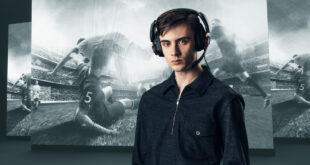Console esports simply wouldn’t be at the level they are today if it wasn’t for highly-modified competitive controllers. The latest – and arguably greatest – such controller is the new Evil Shift from Evil Controllers, which is due to be released later this summer.
Such controllers allow competitors to perform better, which, putting aside the competitive advantage for individuals, makes the game more appealing to watch, and their ergonomic designs make those endless hours of practice much safer.
In a way, that’s putting the cart before the horse, though. Modified competitive controllers have existed for at least ten years now, it’s just that esports has brought them to greater prominence due to the exposure and commercial deals that surround this key endemic player in the still nascent industry.
Instead, the birthplace of such modded controllers was with gamers who simply wanted to be more competitive online – which is exactly where Evil Controllers founder and president Adam Coe’s initial motivation came from.
EVIL SCHEMES
Evil Controllers is one of the original trailblazers in this space, Coe explains to us in a hotel suite with an incredible view over the Los Angeles Convention Center during E3.
“This is our ten-year anniversary, we started the company back in March 2007,” he recalls. “I was your typical Halo 2 gamer: 19 years of age in my dorm room and wanting to improve my gameplay.” He then hit upon the concept of relocating buttons to the underside. “I applied that to my controller and instantly changed my gaming forever.”
Coe was also quick to realise the business possibilities of his modified controller. “I used the last of my student loan money, around $500, and bought 20 controllers off eBay. I instantly started selling controllers, I think the second day after making my own.”
At first, he was selling the modified controllers back on eBay, but then moved to a dedicated website and was successful enough to quit college: “I left after my freshman year and pursued my dream of evolving the industry of video game controllers and gaming in general, striving to become a pioneer in innovation and design.”
Based on our limited time with the Evil Shift, it looks like he’s certainly achieved that.
Evil’s key competitor is Scuf, but Microsoft also made a move into the space with its 2015 Elite Controller. “Other esports controllers have taken various approaches and improved upon the initial two-button underside designs,” admits Coe, but he’s still pretty critical of the competition’s designs, as you’d expect.
He has all the big-selling controllers, both first-party and modified, laid out on a table between us. Picking up a recent Scuf controller, he explains his issues with the design.
“This controller has four paddles in a vertical position. What’s unique is that the paddles have a larger surface area, so you can reach them easily. The limitation to the design is the fact that you can’t utilise all four paddles at the same time. You can only use 50 per cent of the product, which is obviously a limitation.
“The fact that they are hinged off the backplate of the controller gives you the perception you can press them from any direction, when in actuality you can only press the lower-third part. Additionally, the concept of esports is all about speed and multiple button presses, and the idea of having to reach for a paddle to initiate a function faster negates that concept.”
He then moves onto Microsoft’s Elite controller, where he’s not happy with the ergonomics: “They obviously spent a lot of money in terms of research and design, making sure that this was the proper shape [brandishing a standard Xbox One controller], but interestingly they then add paddles to that design, changing the ergonomics and causing you to hold the controller differently.”
Picking up the Elite ourselves, we’re reminded just how heavy it is, a combination of its epic build quality and the numerous rumble motors, which are removed from true competition-class devices. Coe agrees: “It’s extremely heavy, and you have four fingers supporting this heavy controller, so you tend to hit the paddles unintentionally.
“When we’re talking esports and competitive play, cosmetics are not the primary focus. The primary focus is speed, usability, comfort and durability. This is the first Elite from Xbox, but I doubt it’ll be the last and hopefully we can have an influence on that.”
SHIFTING GEARS
So having comprehensively criticised the competition’s efforts, Coe finally comes around to unveiling Evil’s latest effort, claiming simply that “the Evil Shift is the fastest esports controller on the market.”
As with Evil’s other devices, the new controllers are designed to stay close to the familiar, first-party PS4 and Xbox One devices they improve upon. “We keep to the same form factor, the existing ergonomics [of the] controller that millions of gamers already own. The goal was to create a controller that was simplistic in design but extremely effective in its output.”
Current Evil controllers use four discrete buttons on the rear side, but here they are replaced by four larger paddles. “Visually, you see that there are two paddles on each side that rest below your fingers naturally, but what’s different is that these are not hinged off the housing of the controller. They are actually hinged off the switch itself.
“And the beauty of this switch is that it’s not like a typical up-and-down button. This can be pressed up and down, left-to-right, any direction.
“The idea is that you grip the controller as you would naturally, but with the addition of four paddles you can simultaneously press.”
It works well in practise, too, with the paddles sitting comfortably below our fingers and reacting to practically any input motion we try.
When we’re talking esports and competitive play, cosmetics are not the primary focus. The primary focus is speed, usability, comfort and durability.
Adam Coe, Evil Controllers
He moves on to the thumbsticks: “These are removable, as easy as pulling them out of the controller. They come in three different heights, and no proprietary tool is needed. The beauty of this design, of being able to pull them in and out on the fly is that you can quickly make those in-game changes if necessary.”
The triggers have a full range of movement, with no physical lockouts to try and improve single-shot speeds, but Coe claims that “by reducing the spring tension by over 50 per cent, you can actually pull the trigger faster than any other esports controller on the market.”
Finally, the controller has super-sensitive face buttons. “Esports is a game of milliseconds,” he says. “So our buttons travel just 0.3mm and they’re essentially touch buttons, so you’re able to hit the button instantaneously.”
But despite the short travel, there’s still both clear tactile and audio feedback – you know you’ve pressed it.
“All four features, the paddles, the thumbsticks, the hairpin triggers and the sensitive buttons, all shave milliseconds off of your game, allowing you to maximise all the features that are offered – with no limitations. Tie them together and you’re saving time.”
Coe is quite the salesman, and this is a persuasive pitch. He obviously believes deeply in the product that Evil has created – and having tried it for ourselves, it certainly appears to have advantages over what’s currently available from its key competitors.
That said, there’s still an uphill battle Evil Controllers has to climb against the incumbent Scuf devices, which were universally used by all Call of Duty Championship finalists last year. However, when we put this to Coe, he remains unfazed and determined: “I’m 29 years old, so this has been a third of my life,” he says. “This is my life, my career.”
We quiz Coe on his plans to get his controller into UK retail, but there’s no news to report just yet: “We have a rollout strategy that we’re not in a position to discuss yet,” he replies.
We should hear more soon about the company’s plans to bring the controller to customers, however: “We’re looking at end of summer, so we plan on moving quickly,” he says when we ask about the company’s manufacturing plans. He’s been using the controller himself for quite some time, but Evil was waiting for patents to be filed before it could unveil it at E3.
Pricing is also yet to be finalised, but will be “in line with other esports controllers on the market,” Coe says.
Only time will tell whether it actually outperforms the latest Scuf devices in the hands of professional players, and even then with sponsorship deals in place, there’s no guarantee that simply being better will translate smoothly into the kind of exposure that Scuf has seen in recent years. That said, professional gamers and streamers will make up their own minds and consumers will follow the decision these key influencers make.

 MCV/DEVELOP News, events, research and jobs from the games industry
MCV/DEVELOP News, events, research and jobs from the games industry




